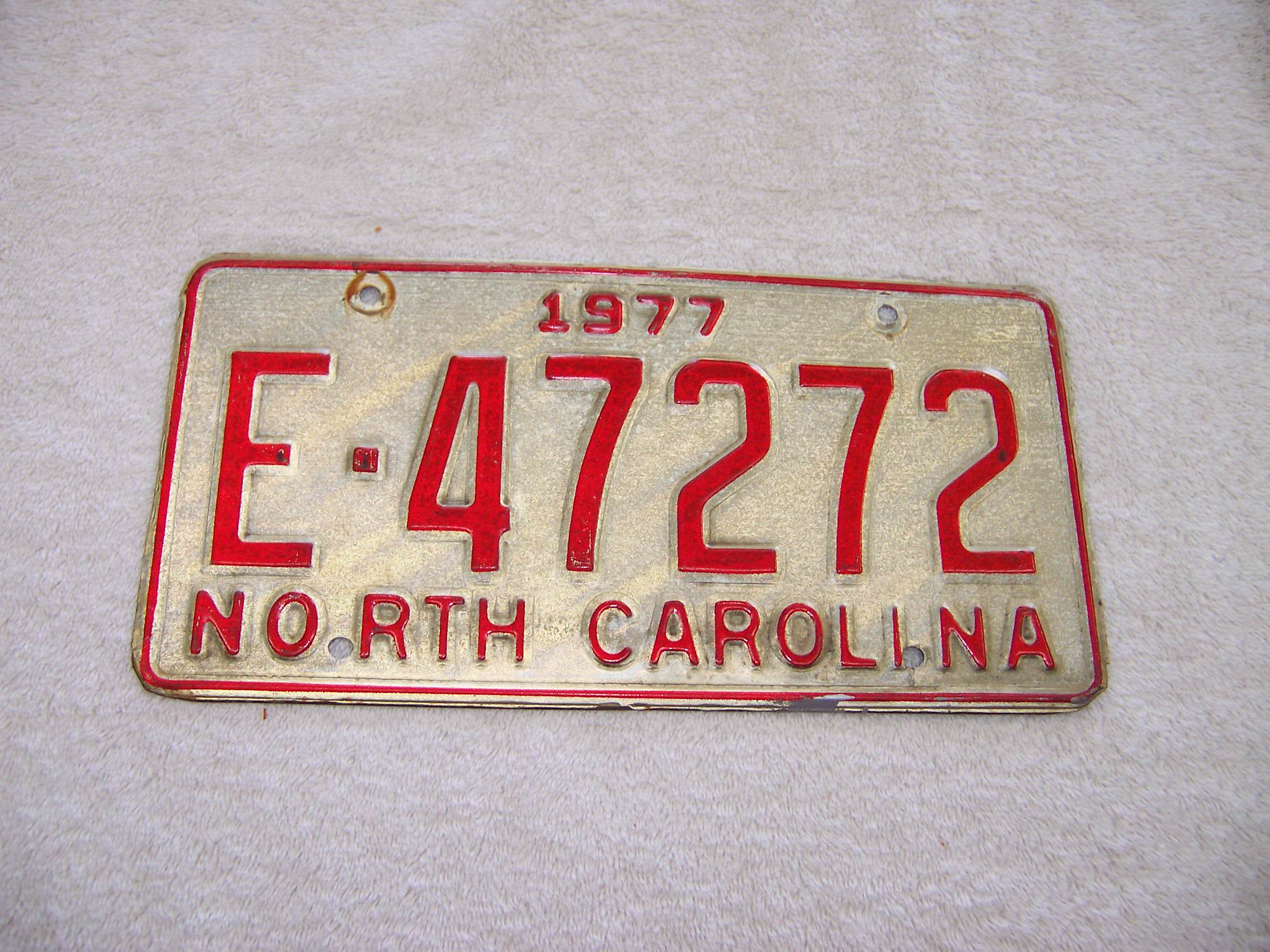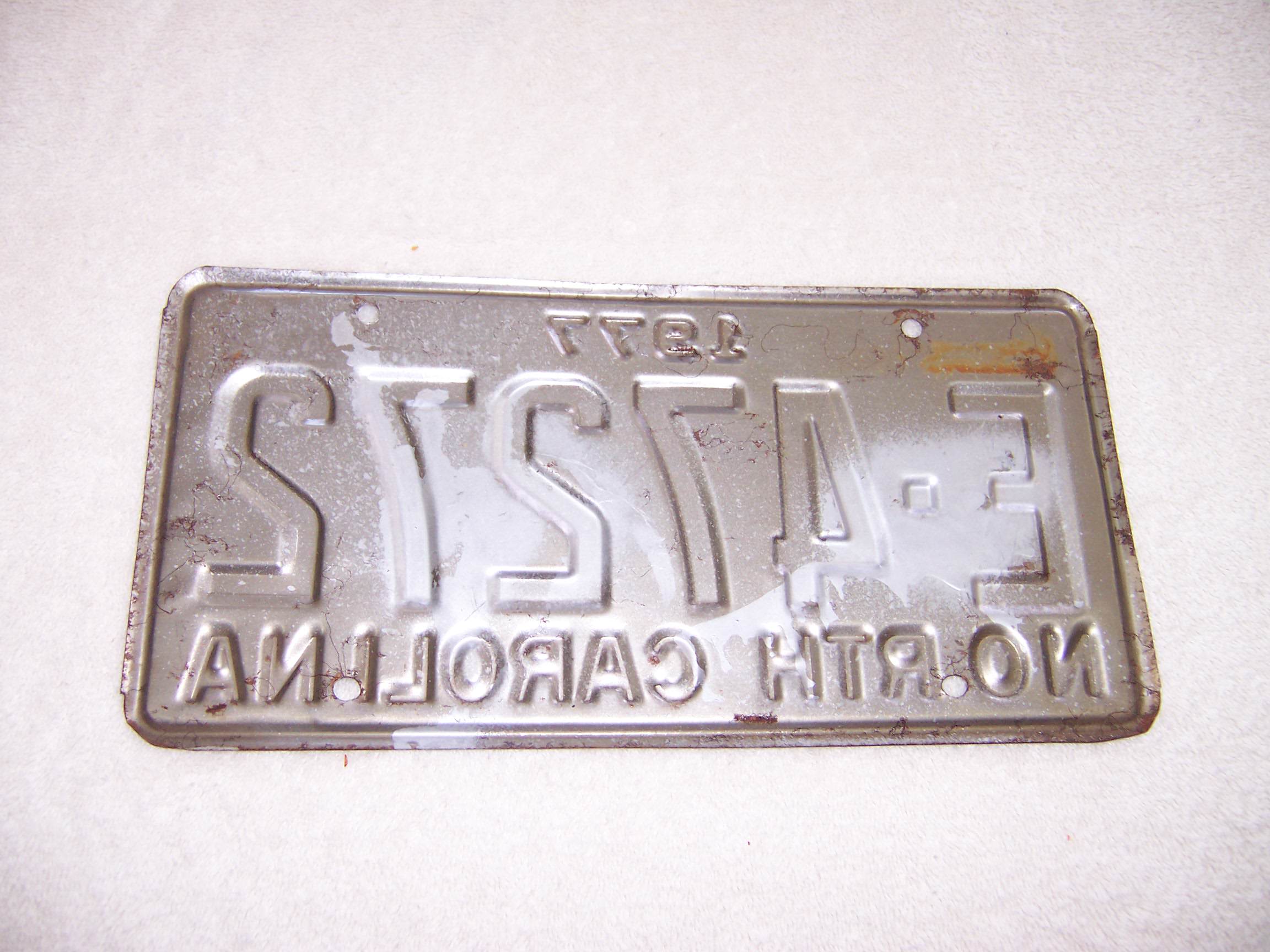Description
1977 North Carolina License Plate in good condition. It measures 6″ high x 12″ x 1/8″.
A vehicle registration plate is a metal or plastic plate attached to a motor vehicle or trailer for official identification purposes. The registration identifier is a numeric or alphanumeric code that uniquely identifies the vehicle owner within the issuing region’s database. In some countries, the identifier is unique within the entire country, while in others it is unique within a state or province. Whether the identifier is associated with a vehicle or a person also varies by issuing agency. Depending on the country, the vehicle registration plate may be called a license plate (United States, Canada), or number plate (India, United Kingdom, Australia).
Legal requirements[edit]
A car registration plate as seen in the United Kingdom.
Most governments require a registration plate to be attached to both the front and rear of a vehicle, although certain jurisdictions or vehicle types, such as motorboats, require only one plate, which is usually attached to the rear of the vehicle. National databases relate this number to other information describing the vehicle, such as the make, model, color, year of manufacture, engine size, type of fuel used, mileage recorded (and other similar data in jurisdictions where vehicles are regularly inspected for roadworthiness every year or two), Vehicle Identification (Chassis) Number, and the name and address of the vehicle’s registered owner or keeper.
In the vast majority of jurisdictions, the government holds a monopoly on the manufacturing of vehicle registration plates for that jurisdiction. Either a government agency or a private company with express contractual authorization from the government makes plates as needed, which are then mailed or delivered to vehicle owners. Thus, it is normally illegal for private citizens to make and affix their own plates, because such unauthorized private manufacturing is equivalent to forging an official document. The notable exception is the United Kingdom, where the government merely assigns plate numbers but it is the owner’s responsibility to find an approved private supplier to make a plate with that number. Similar procedures apply also in Germany and France, for example.
In some jurisdictions, plates will be permanently assigned to that particular vehicle for its lifetime. Some countries permit the re-registration of the vehicle with “personal” (“vanity” or “Cherished Mark”) plates. If the vehicle is destroyed or exported to a different country it will require re-registering in the country of import. China requires the re-registration of any vehicle that crosses its borders from another country, such as for overland tourist visits, regardless of the length of time it is due to remain there; this has to be arranged with prior approval.
In others, such as U.S. states, they may require periodic changing. For cost-saving reasons the tendency for the past three decades has been to replace a small decal on the plate or to use a decal on the windshield to indicate the expiration date of the registration. Some jurisdictions follow a “plate-to-owner” policy, meaning that when a vehicle is sold the seller removes the current plate(s) from the vehicle. Buyers must either obtain new plates or attach plates that they already hold, as well as registering their vehicles under the buyer’s name and the plate number. A person who sells a car and then purchases a new one can apply to have the old plates put onto this car. One who sells a car and does not buy a new one may, depending on the local laws involved, have to turn the old plates in or destroy them, or may be permitted to keep them. Other states keep the plate with the vehicle when ownership passes.
Plates are usually fixed directly to a vehicle or to a plate frame that is fixed to the vehicle. Sometimes, the plate frames contain advertisements inserted by the vehicle service centre or the dealership from which the vehicle was purchased. Vehicle owners can also purchase customized frames to replace the original frames. In some U.S. states license plate frames are illegal. Plates are designed to conform to standards with regard to being read by eye in day or at night, or by electronic equipment. Some drivers purchase clear, smoke-colored or tinted covers that go over the licence plate to prevent electronic equipment from scanning the licence plate. Although some are legal in the United States, many of these covers are not, and their use is discouraged in other countries. The British system of traffic and DVLA number recognition system cameras incorporate filter systems that make such avoidance attempts unworkable, usually with infra-red filters.
Many jurisdictions have reciprocal agreements with other jurisdictions, allowing license plates from other jurisdictions to be used in their jurisdiction. For example, if a vehicle is registered in any U.S. state (or the District of Columbia or a U.S. territory or possession), under federal law that vehicle may be driven into any other U.S. state, and, under international agreements and treaties, into some other countries including Canada and Mexico. The U.S. Government issues license plates directly for government owned vehicles and for foreign diplomats.
Plate design considerations[edit]
An engineering study by the University of Illinois published in 1960 recommended that that the state of Illinois adopt a numbering system and plate design “composed of combinations of characters which can be perceived quickly and accurately, are legible at a distance of approximately 125 feet (38 m) under daylight conditions, and are readily adapted to filing and administrative procedures.” It also recommended that a standard plate size of 6 inches by 14 inches be adopted through the United States to replace the earlier 6 inch x 12 inch size to allow longer registration numbers to be displayed without excessively tight spacing or excessively thin or narrow characters. [1]
History[edit]
Licence plates have been around for longer than there have been automobiles. France was the first country to introduce the licence plate with the passage of the Paris Police Ordinance on August 14, 1893,[2] followed by Germany in 1896.[3] The Netherlands was the first country to introduce a nationally registered licence plate, called a “driving permit”, in 1898. Initially these plates were just sequentially numbered, starting at 1, but this was changed in 1906.
In the U.S., where each state issues plates, New York State has required plates since 1903 (black numerals on a white background) after first requiring in 1901 that only the owner’s initials be clearly visible on the back of the vehicle.[4] At first, plates were not government issued in most jurisdictions and motorists were obliged to make their own. In 1903, Massachusetts was the first state to issue plates.
UK plates were first required from 1 January 1904 by the 1903 Motor Car Act.[5]
Materials[edit]
The earliest plates were made of porcelain baked onto iron or ceramic with no backing, which made them fragile and impractical. Few of these early plates survived. Later experimental materials include cardboard, leather, plastic, and, during wartime shortages, copper and pressed soybeans.
Sizes[edit]
Early 20th century plates varied in size and shape from one jurisdiction to the next, such that if someone moved, new holes would need to be drilled into the automobile’s bumper to support the new plate. Standardization of plates came in 1957, when automobile manufacturers came to agreement with governments and international standards organizations. While peculiar local variants exist, there are three basic standards worldwide.
520 by 110 mm (20.5 by 4.3 inches) or 520 by 120 mm (20.5 by 4.7 inches) – in the bulk of European countries and many of their former overseas territories, as well as South Korea. 450 by 100 mm (17.7 by 3.9 inches) – in Syria and Tunisia.
440 by 120 mm (17.3 by 4.7 inches) – in South Africa and Finland.
430 by 110 mm (16.9 by 4.3 inches) – in Jordan.
420 by 120 mm (16.5 by 4.7 inches) – Previously in Serbia.
372 by 135 mm (14.6 by 5.3 inches) – in Australia and some other Pacific Rim countries, about halfway between the dimensions of the other two standards, longer than Western Hemisphere plates but taller than European ones. 360 by 125 mm (14.2 by 4.9 inches) – in New Zealand.
395 by 135 mm (15.6 by 5.3 inches) – Previously in Indonesia.
390 by 120 mm (15.4 by 4.7 inches) – in San Marino and previously in Finland (before 2001).
430 by 135 mm (16.9 by 5.3 inches) – in Indonesia.
440 by 140 mm (17.3 by 5.5 inches) – in China.
400 by 130 mm (15.7 by 5.1 inches) – in Chile, Brazil, and Argentina.
305 by 152 mm (12.0 by 6.0 inches) or 305 by 160 mm (12.0 by 6.3 inches) – in the majority of the Americas (occasionally in Switzerland and Liechtenstein) and many Persian Gulf countries. 350 by 155 mm (13.8 by 6.1 inches) – in Uruguay.
330 by 165 mm (13.0 by 6.5 inches) – in Japan.
330 by 155 mm (13.0 by 6.1 inches) – Previously in South Korea, but now uses European size plates.
330 by 140 mm (13.0 by 5.5 inches) – in Andorra
340 by 110 mm (13.4 by 4.3 inches) – Previously in Belgium.
340 by 150 mm (13.4 by 5.9 inches) – in Thailand.
320 by 150 mm (12.6 by 5.9 inches) – in Paraguay and Taiwan.
310 by 155 mm (12.2 by 6.1 inches) – Smaller size in Saudi Arabia.
from 275 by 200 mm (10.8 by 7.9 inches) to 340 by 220 mm (13.4 by 8.7 inches) – two line pattern, optional in several European countries for off-roads; 275 by 205 mm (10.8 by 8.1 inches) is standard in Vietnam for rear plates.
Countries with smaller front plates:
360 by 110 mm (14.2 by 4.3 inches) – Italy, Oman also uses same size in both front and rear plates.
300 by 80 mm (11.8 by 3.1 inches) – Switzerland and Liechtenstein
260 by 110 mm (10.2 by 4.3 inches) – Monaco
340 by 120 mm (13.4 by 4.7 inches) – Previously in Luxembourg (before 2003)
320 by 90 mm (12.6 by 3.5 inches) – Iraq


